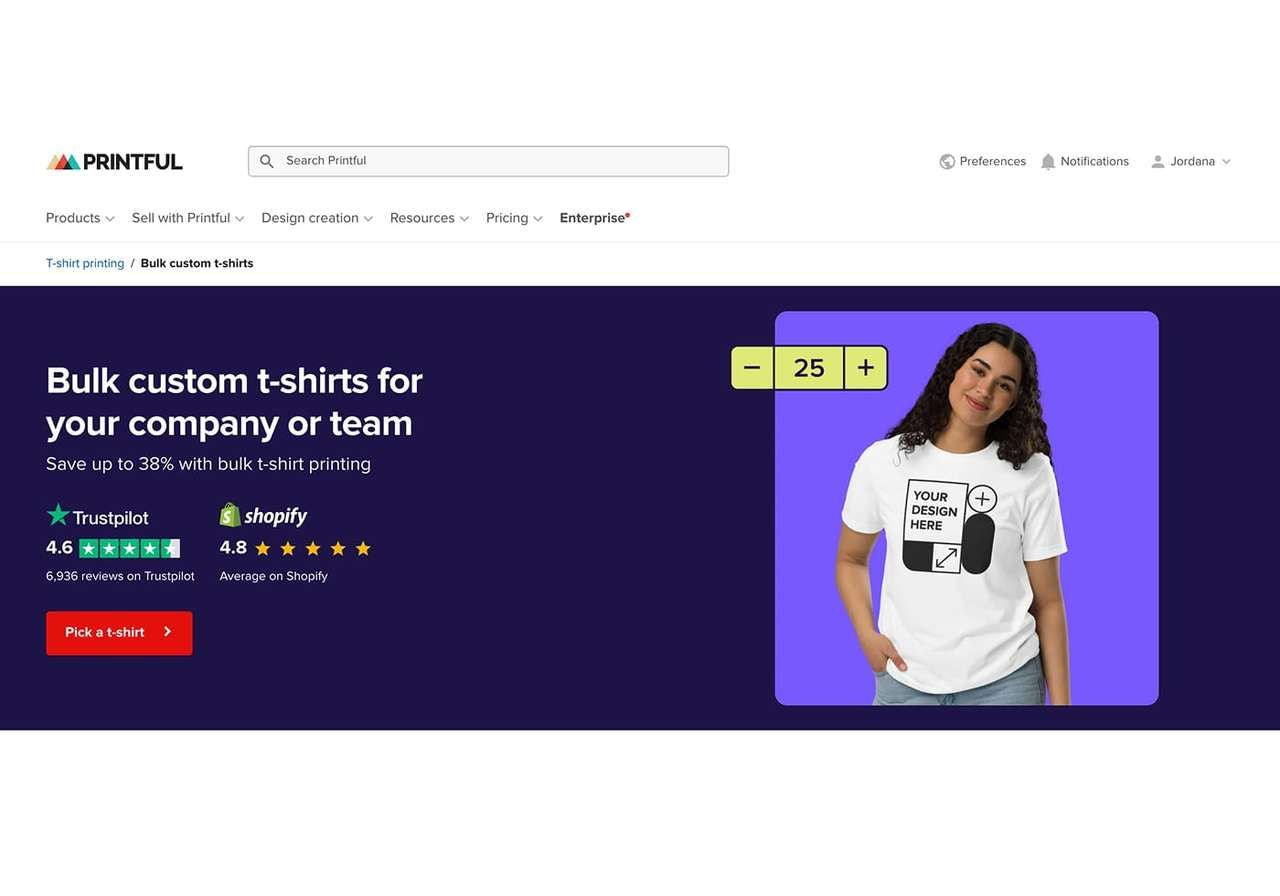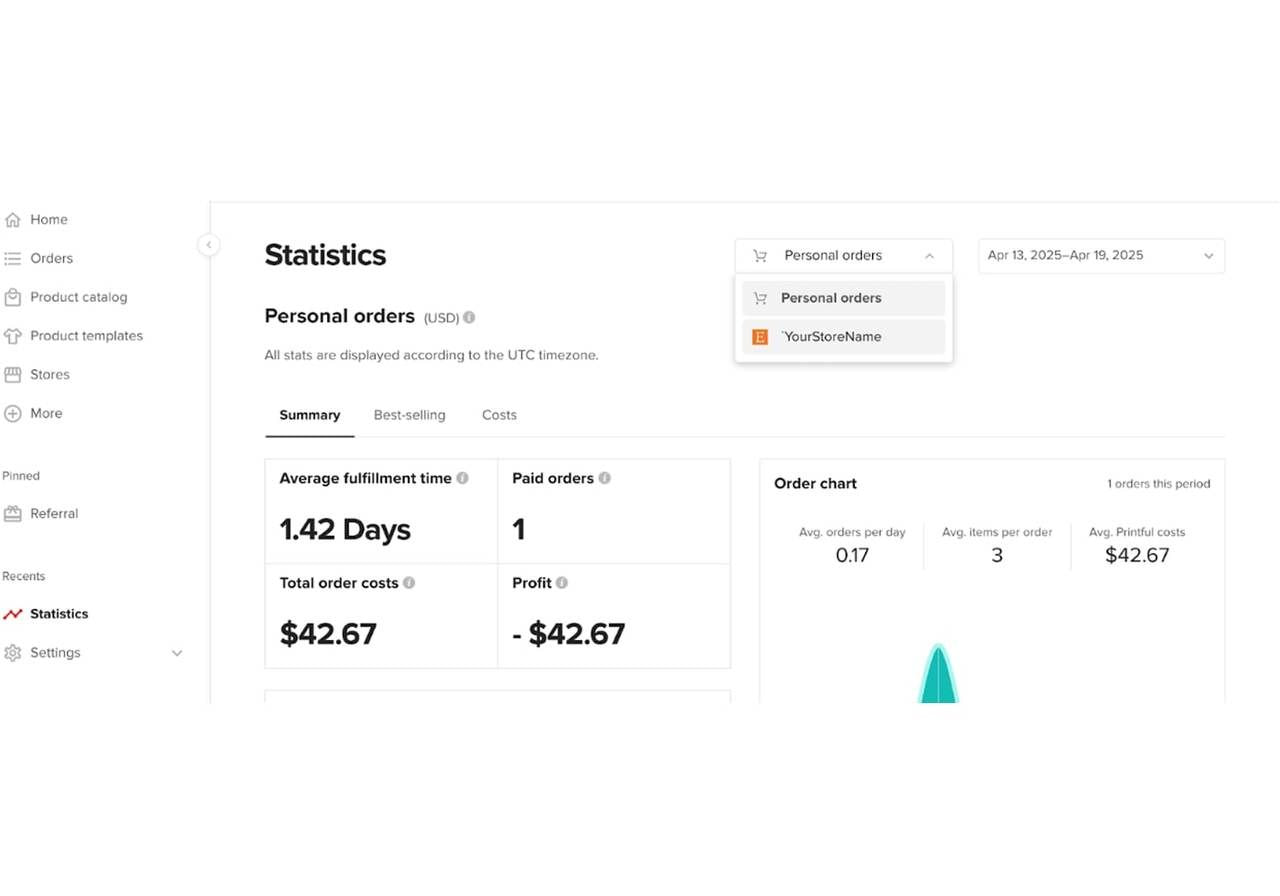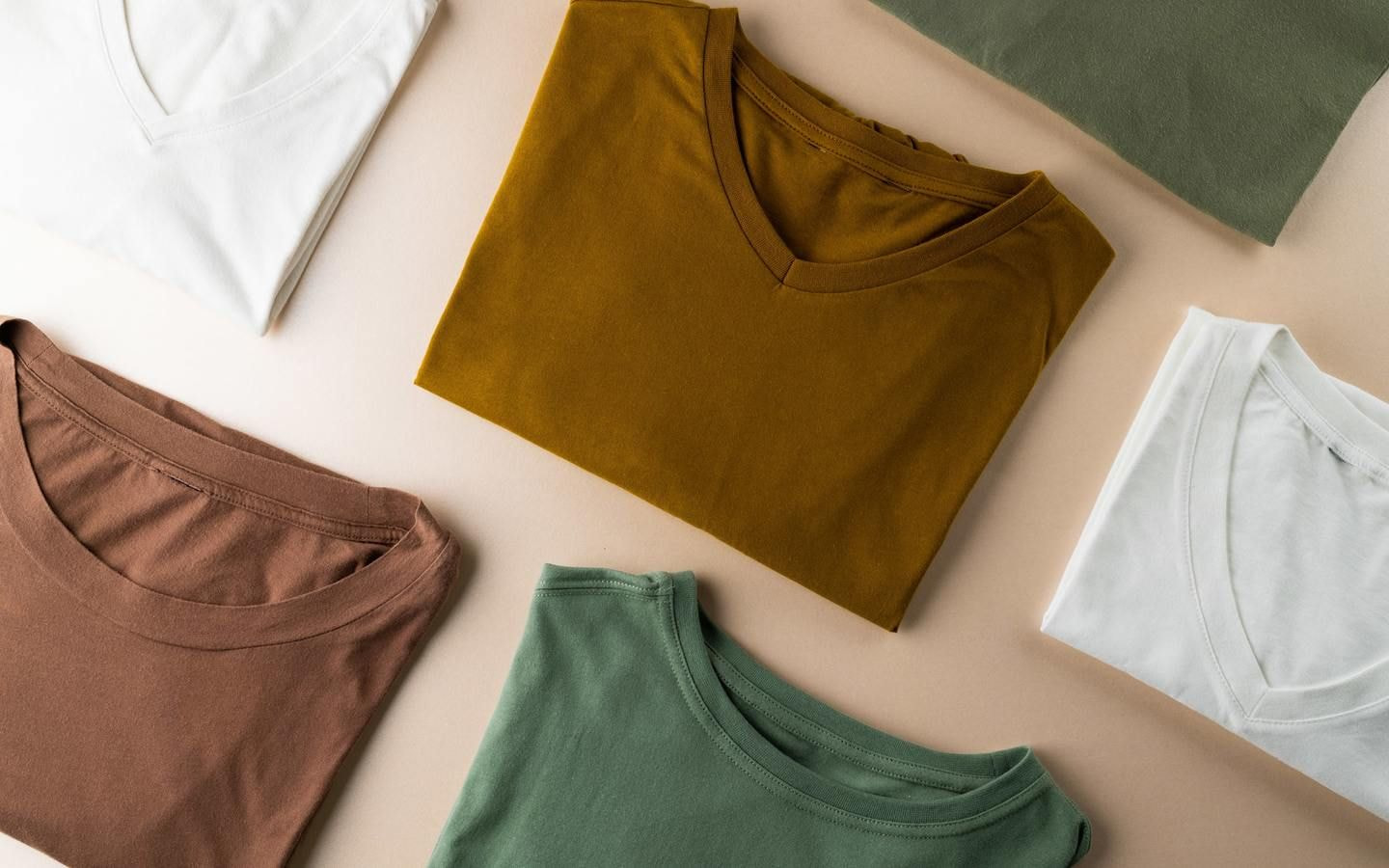Table of contents
Setting the right price can make or break your apparel business. If you need tips on how to price custom shirts, this is your guide. A t-shirt pricing calculator strikes the balance between covering your costs and earning a healthy profit.
We’ll show you how to price your custom t-shirts with confidence, calculate your total cost, and grow a profitable apparel business without guesswork.
Why does t-shirt pricing matter?
When you ask, “How much should I charge for custom shirts?”, you’re not alone. Pricing isn’t just about picking a number – it’s about balancing what customers are willing to pay and what keeps your t-shirt pricing profitable.
Set your prices too high, and you risk lower sales. Go too low, and you cut into your profit margin or fail to cover your total costs.
Pricing also shapes your brand’s identity. A premium price signals higher quality and exclusivity, while a lower one attracts budget-conscious buyers.
Before deciding on your numbers, make sure you understand every cost component – from your product base price and printing choices like direct-to-film (DTF) transfers to shipping costs and platform fees.
This knowledge helps you reach your desired profit margin and build a profitable t-shirt business that keeps customers coming back.
How to calculate your t-shirt price (quick formula)
Here’s the fastest way to calculate your t-shirt price:
Final price = Total cost × (1 + Desired profit margin)
Total cost includes your product base price, printing, shipping costs, platform fees, and taxes. Add those up, choose your desired profit margin, and plug in the numbers.
Example: If your total cost is $12 and you want a 40% desired profit margin, price the shirt at $16.80.
Key factors to include in your pricing formula
Before you start crunching numbers, it’s important to understand what goes into your t-shirt pricing formula. Here are the key factors to consider when you determine how to price your custom t-shirts for profit.
Product and printing cost
This is the core of your pricing structure. It covers the cost to procure the blank t-shirt, your chosen printing method, and any customization or finishing touches.
For example, your DTF transfer cost can vary depending on design size and color use. A small, one-color logo on the chest may cost less than a full-front multicolor print. If you’re ordering in larger quantities, your cost per shirt often drops.
Always review these details before finalizing your total cost so your t-shirt pricing stays accurate and profitable.
Here’s a printing method cheatsheet with cost implications:
|
Method |
Best for |
Setup |
Unit cost behavior |
Typical order size |
Notes that affect price |
|
DTG |
Small runs, full-color |
None |
Flat-ish per unit |
1-50 |
Soft hand, darker garments often need pretreat or a white underbase |
|
DTF |
Versatile fabrics, vivid color |
Low |
Per-area transfer |
1-200 |
Great for sleeves or back hits, per-placement increases cost |
|
Screen printing |
Bulk, few colors |
High (screens) |
Drops sharply at volume |
50-5,000 |
Each color adds setup, excels at 1-3 colors |
|
Embroidery |
Logos, premium feel |
Digitizing fee |
Per-stitch/time |
1-500 |
Small placements (chest or cuff) stay cost-efficient |
Shipping costs
Whether you include shipping fees in your t-shirt price or charge delivery separately, always account for the cost of shipping each order.
Don’t forget to calculate package weight, international rates, return shipping, and packaging materials – these smaller items add up fast.
Marketplace or platform fees
Every platform you sell on has its own seller fee structure. Marketplaces like Etsy or Amazon often charge listing, transaction, or payment processing fees, while platforms like Shopify or Squarespace require monthly subscriptions and processor charges.
If you use Printful, your production and fulfillment are already built into the base product cost. Just ensure that you include these platform-related expenses in your pricing formula so you accurately determine your total cost per sale.
Taxes and payment processing fees
Every t-shirt business must handle sales tax, VAT, and payment processing fees, which can quietly eat into your profit margin.
If you’re selling t-shirts with Printful, applicable taxes are automatically added based on the customer’s destination and remitted where required. Running your own online store, however, means you’re responsible for collecting and paying those taxes yourself.
In both cases, include these charges in your t-shirt pricing formula to avoid unexpected losses.
Your profit margin target
Your desired profit margin defines how much you want to earn from each product after covering all expenses. Many successful merch sellers aim for a 30-40% markup, depending on their niche, design complexity, and audience.
Let’s say your t-shirt base cost is $10. Setting your retail price at $14 gives you a 40% profit margin – a realistic yet ambitious goal.
Creators with strong brand equity or limited drops may push 100-200% markup, while wholesale generally aims for 50% retailer margin. Choose the range that fits your model.
How to price your custom t-shirts: Step-by-step walkthrough
Now that you know all the parts of your t-shirt pricing formula, here’s how to use a t-shirt pricing calculator effectively:
1. Enter your product base cost
Start with the base price of your blank t-shirt. This includes the cost of the garment and basic production to produce what you intend to sell.
If you’re partnering with Printful, explore our Product Catalog and select your preferred t-shirt brand, printing method, color, and size. The page automatically displays the base product price, including any discounts from your Printful Growth plan.

Source: Printful
2. Add printing and shipping fees
Each printing method has its own price range. Screen printing is often the most cost-effective for bulk orders, while direct-to-garment (DTG) suits low-volume or custom designs at a slightly higher rate.
Design placement also influences your cost. Printing on multiple areas – the front, back, or sleeves – increases the total price, as each print location requires extra setup and materials.
When it comes to shipping, remember to include international rates, packaging materials, or any special handling fees that may apply.
Pro tip: Preview your design in mockups with various printing techniques before finalizing your products. Compare costs and find the best method for your designs and budget hassle-free.
3. Include marketplace or payment fees
Add any seller fees or payment processing charges based on where you sell.
For example, Shopify charges a transaction fee starting at 2.5% + $0.30 per sale, depending on your plan. Etsy adds a $0.20 listing fee per item plus a 6.5% transaction fee on the displayed price.
If you’re using Printful to fulfill orders, your platform and transaction fees will vary depending on your connected eCommerce platform – check our payments guide for a full breakdown.
4. Choose your desired profit margin or t-shirt selling price
Determine how much you want to earn per t-shirt. Pick one of two ways:
-
Profit margin-based pricing: Start with your total cost and add a percentage (for example, 40%) to determine your selling price.
-
Market-based pricing: Set a selling price based on competitor rates, then calculate the profit margin you’ll earn.
Both approaches work – just ensure your t-shirt pricing covers all costs and supports your profit goals.
5. The calculator outputs your results
Once you have all your numbers, create your own t-shirt pricing calculator.
Here’s a quick way to calculate your t-shirt’s ideal retail price:
Final retail price = (Base product cost + Printing + Shipping + Fees + Taxes) × (1 + Desired profit margin)
This calculator works because it factors in every expense before adding your profit margin. That way, your prices always cover costs and generate consistent earnings – no guesswork.
Let’s use the Bella + Canvas 3001 Unisex T-Shirt as an example.
-
T-shirt base price: $11.75
-
Delivery: starts at $4.75
-
Desired profit margin: 50%
Calculate the retail price as follows:
($11.75 + $4.75) × 1.5 = $24.75
Your final price would be $24.75, giving you a total profit of $8.25 per shirt.
Tips for optimizing t-shirt pricing
Custom t-shirt pricing is an ongoing process. Since your t-shirt pricing calculator depends on many moving parts, regular testing and adjustments help your business remain both competitive and profitable.
Here are a few pricing tips to help keep your profit margin in the green.
Do competitor analysis
Research what similar sellers charge on Etsy, Shopify, Amazon, and other channels. Calculate their average prices, shipping rates, and discounts.
Understanding your market helps you position your products strategically without undervaluing your work.
Set the right pricing strategy
Use your research to choose a pricing strategy that fits your niche. Limited drops, premium designs, or niche audiences may support higher markups, while everyday basics perform better at competitive prices.
Offer special deals
Encourage larger orders with bundle deals or volume discounts. For example, “Buy two, get one 20% off.” Promotions like these drive purchases and total profit while helping you move products faster.
With Printful’s bulk custom t-shirt deal offering up to 38% off, you can lower your total cost and extend part of the savings to your customers. This way, you maintain prices attractive while still earning a solid profit margin.

Reassess regularly
Your costs and the market aren’t static. Revisit your t-shirt pricing whenever shipping, supplier rates, or consumer demand change. Even a small adjustment can make a big difference in maintaining your desired profit margin.
Discover our special offers for bulk discounts of up to 55% and more.
Test price flexibility
Finally, don’t be afraid to experiment. Try adjusting your t-shirt pricing slightly – say, by a dollar or two. Track how it affects your sales volume and total profit. If your sales stay steady at a higher price, that’s your sign to keep it. If they drop, roll back, and test again.
Printful customers can access store statistics from their Dashboard to see how pricing changes influence conversions. Go to Dashboard, then click More > Statistics in the left-hand menu and select your store from the dropdown.

Work smarter, not harder: Discover other expert tips and examples to increase your t-shirt business profit margin and keep more earnings per purchase.
Common mistakes to avoid
Finally, even a great t-shirt pricing formula can fall short if you overlook key details. Watch out for these common mistakes that can cut into your profits.
Forgetting to include all hidden fees or taxes
Overlooking small expenses – like payment processing fees, platform commissions, or local taxes – can quietly reduce your total profit. Always double-check that every charge is reflected in your t-shirt pricing calculator.
Ignoring international shipping or currency differences
If you sell globally, remember that shipping costs and currency exchange rates vary. Update your pricing to reflect these differences so you don’t lose money when you sell overseas.
Copying competitors’ prices blindly without cost analysis
It’s tempting to match other sellers, but their total cost and margin structure may be completely different. Use market research as a reference, not a rule, and base your own t-shirt pricing on your numbers and desired profit margin.
Make sound decisions using market research tools – check our review to compare and contrast the options available.
Undervaluing your time or design effort
Your time and creativity have real value. Include your labor so your prices reflect the effort and originality behind each product.
If you use artwork from other creators, factor in any commission fees or licensing costs.
And most importantly, never plagiarize or use copyrighted materials without permission. This can lead to account suspension, legal issues, and serious brand damage.
Looking for inspiration? Check out our t-shirt design ideas for successful designs and examples.
Conclusion
Getting your custom t-shirt pricing right is all about balance – covering your costs, keeping a healthy profit margin, and staying competitive in your market.
Once you understand how each factor affects your total cost and how the pricing calculator works, you’ll know exactly how to price custom shirts without guesswork.
With Printful, you get clear product pricing, automated fulfillment, and worldwide shipping, so you can focus on what you do best – creating designs your customers love.
Start working with Printful today for a hassle-free pricing process that helps your business grow at its own pace.
Read next for more print-on-demand and pricing tips:
FAQ
To calculate your shirt price, add up your total cost – including shirt materials, printing, shipping, and fees – then add your desired profit margin. This gives you the amount you should sell each shirt for to stay competitive and earn consistently.
To price custom clothing, consider your audience and what makes your merch valuable. Once you know your total cost, apply a markup that reflects your brand quality and market. Premium designs or limited editions can support higher margins, while everyday basics benefit from competitive pricing.
A good profit margin for a t-shirt is typically a 30-40% markup, but it can range from 20-50% depending on your market niche and audience. The best answer is to test and adjust your pricing based on what sells in your shop – keeping profits healthy while staying competitive.
The average price for a t-shirt depends on quality and brand. A basic tee ranges from $10-$30, while Printful t-shirts from brands like Gildan and Bella + Canvas start at around $7.50. From there, calculate your retail price based on your profit margin and audience.

Jordana is a content writer with over 6 years of experience in content writing and technical writing. Her not-so-secret passion is breaking down complex ideas into clear, straightforward content, whether it's explaining tech concepts or crafting stories that connect. When she's not writing, you'll find her enjoying good sushi or falling down movie trivia rabbit holes.





